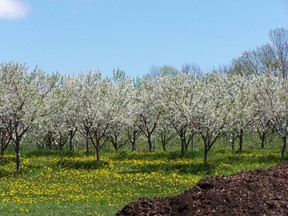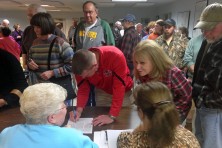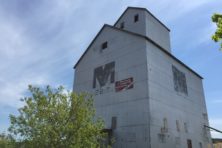Budget Uncertain for Agricultural Research Stations
- Share
- Tweet
- Pin
- Share
It wasn’t long ago that the Peninsular Agricultural Research Station in Sturgeon Bay was threatened with the ax. In 2011, the station faced staggering budget cuts, potential closure and an uncertain future.
While conditions have improved – nobody’s proposing to close the station anymore – things still aren’t easy. The governor originally proposed increasing state funding to the UW system, but since the system was discovered to have almost $650 million in reserve while continuing to raise tuition, legislators and the governor have called for funding cuts and a tuition freeze.

Matt Stasiak, supervisor and outreach specialist at the Peninsular Agricultural Research Station. Photo by Carol Thompson.
“[The UW system] has enough to run for three months, and that’s not high by any standards,” said Dean Volenberg, Door County Extension agriculture agent. “And that’s not the point. The point was that it wasn’t more transparent, and that’s why the legislature’s ticked off… I wouldn’t say the research station is out of the woods until we see some kind of budget passed down through the legislature and we see what kind of funding comes to the university system.”
Agricultural research stations help with real-world application for other university research. The Peninsular Agricultural Research Station sits on 120 acres along Highway 42 north of Sturgeon Bay, and small plots of crops pepper the land. Researchers study fruits such as apples, cherries and grapes, and crops like barley and winter wheat. They try a variety of different growing techniques on the crops to see what works.
Research projects aren’t handed down from the labs in Madison. Projects are usually collaborations between industries, researchers and the research station.
“We tend to be applied, in the field, geared toward the industry,” said Matt Stasiak. “You have a lot of researchers doing research on campus, more basic research… Test tube jockeys. There’s balance there.”
Stasiak oversees the work at the research station. He is the station’s research and outreach specialist, then in December 2011 took over as the station’s superintendent and research specialist, which allowed the station to eliminate a full-time position and save cash.
Stasiak said there are three full-time employees and one part-timer at the research station, and he’s had to cut back on hiring student and summer help. Salaries and the station’s operating budget, about $17,000, come from the UW system, and outside revenue from projects, gifts and grants cushion the budget.
Some projects, like the scouting program, pay for themselves. The research station hires a scout to travel around the county and survey fields for insects and diseases so farmers know if they need to spray. Farmers pay to have the scout check out their crops, and that revenue pays for his salary.

The cherry orchard used to test organic growing methods at the Peninsular Agricultural Research Station. Photo by Carol Thompson.
The station has had to prioritize research projects based on how they’ll pay for themselves, and cut the ones that cost too much money to operate.
“We’ve had to look at what programs we have done in the past that maybe weren’t fully funded…we’ve eliminated some of those, like some with the small fruits,” Stasiak said. “We’ve got a raspberry planting right now that probably won’t last much longer, probably one more year.”
Stasiak said more people in the agriculture industry are stepping up to fund projects, since they benefit from the research. And while farmers could, and sometimes do, get grants to study growing techniques, they often contract with the station to conduct those studies.
“Most people think research is planting a new variety and seeing how it does,” Stasiak said. “Well you need controls and you need to compare it to a standard. There are certain ways to do that to make it more legitimate as far as science is concerned.”
But the future of programs at the Peninsular Agricultural Research Station and the 11 other stations around the state are uncertain, at least until they know what funding they can receive.
“At this time it’s hard to say what’s going to happen until the budget gets passed,” Volenberg said.



